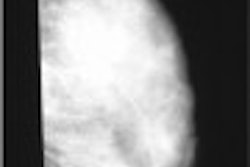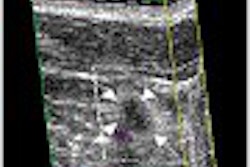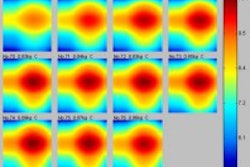It’s a fact that cancers get missed on breast screening exams. Some are just not visible, while others are simply overlooked. Computer-aided detection (CAD) has become a valued ally in breast cancer screening, boosting overall detection rates and detecting cancers earlier. The technology’s success has spawned new applications in the lung and colon.
But CAD has its caveats. Even in mammography, CAD won’t turn a poorly performing radiologist into a breast cancer specialist. And the technology may not be cost-effective for every breast center.
That said, CAD is having a dramatic clinical impact on breast cancer screening. Its biggest advantage is its ability to pick up small cancers at an earlier stage than ever before, said Dr. Michael Ulissey, staff radiologist at Women’s Diagnostic of Texas breast center in Plano.
"If we are doing our jobs as mammographers, we are detecting cancer early," he said. "We are picking up two, three, and four-millimeter clusters and microcalcifications all the time, and if they turn out to be precancerous lesions, we can take out that tiny lump and minimize surgery."
CAD technology relies on a variety of computer algorithms to analyze patterns on a digitized image, marking regions that may contain an abnormality. The system may indicate the general type of abnormality -- mass, calcification, or nodule, for example -- but does not make a diagnosis.
In a prospective study based on screening exams performed on almost 13,000 consecutive women over a one-year period, Ulissey and colleagues found that CAD increased breast cancer detection by 20% (Radiology, September 2001, Vol. 220:3, pp. 781-786).
In the two years hence, the team has kept tabs on the impact of CAD on other aspects of breast cancer screening, from patient recall to workflow.
Because CAD marks any region on a screening exam that harbors a possible abnormality, the potential for dramatically increased recall rates was an initial concern, Ulissey said. The center’s recall rate without CAD averaged 6.5%; when CAD was applied, the rate increased to 7.7%.
CAD's strength lies in picking up tiny clusters of microcalcifications, Ulissey said.
"I still read the mammograms myself, and occasionally detect calcium when the computer does not," he said. "But knowing CAD's strength allows me to spend more time looking for masses, which is CAD's weakness. Together, we do a pretty good job."
It’s important for radiologists to rely on their own cancer-detection experience and not solely on the marks that CAD may (or may not) make.
"Don’t say to yourself, ‘I was going to recall this density, but CAD didn’t mark it, so I’ll let it go,’" Ulissey said. "It’s a formula for disaster."
‘Beneficial misses’
There are those who argue that the early cancers CAD often targets are so small that missing them initially would not have changed patient outcome. These so-called "beneficial misses" would most likely be detected on the next annual mammogram, CAD skeptics say, at a stage when they are still small enough to be managed easily.
"There’s two things wrong with that argument," Ulissey said. "First, it’s a little odd to say we want early detection of breast cancer -- but not too early. Second, we can’t assume that a woman will return next year for her screening mammogram. Women often skip two, three, even four years between screens."
For breast centers weighing a CAD acquisition, clinical efficacy certainly plays the largest role. But close behind are economic issues, such as capital costs, procedure volume, and workflow impact.
In a traditional film-screen environment, as opposed to digital, CAD can potentially slow down workflow. Some sites have found it inefficient to implement CAD in a film-based environment, due to the additional time required to manually digitize each screening exam for computer analysis.
"From a cost-effective point of view, the benefits of CAD can only be realized in the digital environment," said Dr. R. James Brenner, medical director of breast imaging at Eisenberg Keefer Breast Center in Santa Monica, CA. "It’s just too laborious. I can’t justify using CAD, regardless of how you feel about the results, in a nondigital environment." Brenner spoke at the 2003 National Consortium of Breast Centers annual meeting in Las Vegas.
But Ulissey, who has yet to invest in digital mammography for his center due to its prohibitive expense, believes the additional time is well worth the effort. At Women’s Diagnostic, it takes about five minutes to digitize each scan, he said.
In terms of the radiologists’ time, evaluating a screening mammogram and the marks made by CAD adds about 10 to 15 minutes per day to batch-reading chores, Ulissey said.
"I’m spending an extra 10 to 15 minutes in the screening room each day in order to pick up 20% more breast cancers. That’s a pretty even trade-off to me," he said. "If nothing else, that extra time spent is lowering my liability."
Billing for CAD
Medicare reimbursement for CAD was established in 2001, and payment amounts received a small boost in 2002. The Center for Medicare and Medicaid Services (CMS) also expanded CAD coverage last year to include diagnostic exams. This year, the agency extended that coverage to incorporate payment for CAD when used with full-field digital mammography.
CAD is treated as an add-on procedure, said Gerald Kolb, president of Breast Health Management, a consulting firm in Bend, OR. It cannot be billed as a stand-alone charge, but is paid when billed in conjunction with a screening or diagnostic mammogram.
CMS pays $15.57 for a CAD procedure conducted in the hospital or office environment. The amount for CAD is the same whether it is used in conjunction with film-screen or digital mammography (CMS also now pays for digital mammography).
| Calculation of contribution margin per mammogram for screening mammography plus CAD (technical component only) | ||||
 |
||||
| Volume/Day | Reimbursement | Annual Cost | Net Revenue | Contribution Margin/Mammo |
 |
||||
| 25 | $97,313 | $77,000 | $20,313 | $3.25 |
 |
||||
| 30 | $116,775 | $77,000 | $39,775 | $5.30 |
 |
||||
| 40 | $155,700 | $77,000 | $78,700 | $7.87 |
 |
||||
| 50 | $194,625 | $77,000 | $117,626 | $9.41 |
 |
||||
| 60 | $244,550 | $77,000 | $156,550 | $10.44 |
 |
||||
| 70 | $272,475 | $77,000 | $195,475 | $11.17 |
 |
||||
| 80 | $311,400 | $77,000 | $234,400 | $11.72 |
 |
||||
| Developed by Gerald Kolb, Breast Health Management, Bend, OR | ||||
"When evaluating a CAD acquisition, look at the impact of capital cost, maintenance, and any additional labor that may be involved in processing the CAD image," Kolb said.
"Once these costs have been paid, the balance of the reimbursement effectively becomes profit."
Ulissey estimates that centers performing 30 or more screening mammograms per day can easily justify a CAD purchase. For others performing fewer studies, several sites offer digitizing and CAD analysis services for a per-exam fee. Ulissey’s own center provides this service to regional practices that lack sufficient screening volume.
In some cases, centers may be able to justify CAD with fewer cases per day. In an analysis of CAD volumes and costs, consultant Kolb estimated a capital acquisition cost of $225,000 for a device capable of digitizing and displaying 96 mammograms during an eight-hour workday.
Assuming maintenance and software upgrade costs at a combined 10%, the cost of an additional technology aide, and factoring in per-exam reimbursement rates, break-even for CAD is about 5,000 cases annually, Kolb said, or about 20 mammograms per day. At higher volumes, the technology becomes more cost-effective (see chart).
But users must also factor in potential differences among CAD devices that could impact workflow, Kolb said. Three FDA-approved CAD systems are now available.
In a presentation at the 2002 RSNA meeting in Chicago, researchers evaluated clinical capabilities of the ImageChecker (R2 Technology, Sunnyvale, CA), the MammoReader (iCAD, Boca Raton, FL) and Second Look (CADx Systems, Beavercreek, OH). Each system performed about the same when it came to cancer detection -- identifying lesions in 90% of cases.
When it comes to system performance, CAD devices do differ in their use of computer algorithms, digitization rates, and methods of display, Kolb said. The differences can add up as processing time, for the technology aide as well as for radiologists, he said.
"Because physician time is so expensive relative to the other costs of CAD, it’s important that system selection be based on how well the device can be integrated into the delivery process, including mammogram interpretation," he said.
Last but not least, CAD may also offer a liability edge, Ulissey said. Radiologists are more frequently targeted for breast cancer litigation than any other specialist. The average judgment is $300,000, and multimillion judgments are not uncommon. Missed cancer is a common reason for such litigation, as is delayed diagnosis.
CAD’s promise in breast imaging has prompted similar software developments in other clinical areas, to be applied in lung and colon cancer screening. Today, CAD beyond the breast is still in the nascent stage -- with only one FDA-approved lung cancer detection device on the market and colon CAD still in the experimental stages.
It’s clear that CAD opportunities exist wherever high-volume screening exams are found, however.
"In any modality in which the radiologist is confronted with a large volume of image information, under conditions that may challenge normal perceptual abilities, CAD may be a useful adjunct, or aid," Ulissey said. "It’s just another tool that is going to help us do our jobs better."
By Deborah R. DakinsAuntMinnie.com contributing writer
June 3, 2003
Related Reading
iCAD Q1 sales jump, May 13, 2003
CADx signs accord with Premier, April 18, 2003
Lawmakers mull mandatory testing of radiologists' skills in reading mammograms, April 8, 2003
R2 outfits Baptist Health South Florida, April 17, 2003
CAD mass markers aid in reduction of mammographic interpretation errors, March 7, 2003
Researchers compare CAD systems for mammography, December 6, 2002
Copyright © 2003 AuntMinnie.com



















